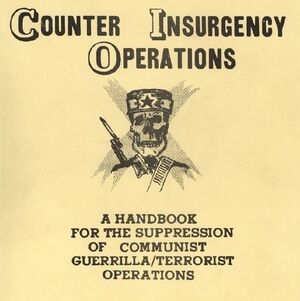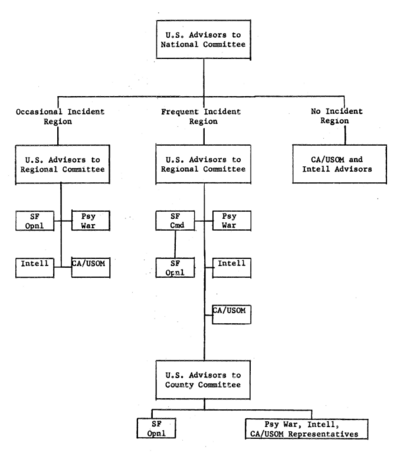A Handbook for the Suppression of Communist Guerrilla/Terrorist Operations (Chapter V)
| Author | Department of the Army |
|---|---|
| Country | United States of America |
| Subject | Counterinsurgency |
Publication date | 1961 |
| Text | A Handbook for the Suppression of Communist Guerrilla/Terrorist Operations online |
| Digital Identifier (JFK Library): JFKPOF-080-014 | |
| Part of a series on |
| Counterinsurgency |
|---|
U. S. INTERESTS
a. The U. S. interest in the target areas lies primarily in preventing further communist expansion by maintaining stable popularly supported non-communist governments in power in the countries of allies, friends, and the so-called neutral or uncommitted nations.
b. In several areas the military forces of these governments constitute major elements of the regional U. S. - allied defense effort. The preoccupation of these forces in combating internal guerrilla/terrorist operations effectively denies their use in opposing external overt aggression.
c. It is neither politically feasible or operationally practicable to entertain the use of U. S. conventional forces in an intervention role within these numerous and widespread areas for the following reasons.
(1) U. S. national policy preventing military intervention in the internal affairs of sovereign states unless threatened by exterior invasion.
(2) Lack of adequate U. S. forces and the general unsuitability of foreign troops in combating internal uprisings.
(3) Resistance of indigenous populations to foreign (U. S.) military intervention.
(4) International implications of "gunboat diplomacy" and its lack of public support abroad and within the U. S.
d. The problem of suppressing guerrilla/terrorist operations is essentially an internal problem of the country concerned and the resolution of the basic issues and the application of appropriate remedial actions must remain in the hands of the indigenous government.
e. The indigenous government faced with revolutionary warfare on a day-by-day basis, however, often finds it difficult to objectively analyze the situation and recognize the sources of the guerrilla/terrorist strength and initiate appropriate counter-action.
f. The U. S. should be prepared to offer assistance and advice at the request of such governments. Scope of such aid should include the following and be considered an economy of force measure.
(1) Assistance in preparing plans.
(2) Organization and training of forces.
(3) Advice in the conduct of anti-guerrilla/terrorist operations.
(4) Furnishing equipment.
(5) Assistance in preparing psychological operations.
(6) Material relief assistance in the form of food, medical supplies', construction materials and equipment.
(7) Assistance in rehabilitating devastated areas.
g. The urgency and general circumstances that surround requests for assistance in combating guerrilla/terrorist operations dictate prompt and positive action.
h. Long range programs and general assistance aid while useful in achieving ultimate goals are largely unproductive and unresponsive to the immediate threat of Revolutionary Warfare placing a communist or communist oriented government in power within the target area.
i. The time element is vital in the suppression of guerrilla/terrorist operations. Prompt remedial action in the advanced conspirational or initiation phase will assist materially in the shortening of the conflict. While the complete suppression of Revolutionary Warfare is generally achieved in a period of years, not months, the overall length of the conflict is often determined by the promptness and nature of the remedial measures applied in the initial months of conflict.
j. U. S. Advisor Assistance: Teams of suitably qualified U. S. military and civilian personnel appropriately trained for the areas of operations should be provided at the compatible levels of indigenous pacification commands to advise and assist the indigenous government. Wherever feasible and possible utilization of U. S. personnel presently in the area should be made.
(1) Military Personnel: U. S. Army Special Forces Teams, Psychological Warfare teams and appropriate specialist representation of civil affairs, counter-intelligence and police corps personnel should provide military representatives on command levels and constitute the basis for working teams, with their indigenous counterparts.
(2) Civilian Personnel: Department of State, U. S. Operations Mission (USOM) personnel should provide civilian representation in respective fields on a similar basis.
(3) Schematic type organization and functions at various levels depicted as follows:
| (a) National level | U.S. Advisor Aid | Indigenous Gov't. Command |
|---|---|---|
| U.S. Country Team Advisors to National Pacification Committee. Ambassador and appropriate members of U. S. military and civilian agencies. | National Pacification Committee
Chief of State Ministers and Appropriate Government Departmental Heads. | |
| (Executive Advisor Committee appointed by Ambassador advises National Executive Sub-committee). | (Executive subcommittee appointed by Chief of State carries out direction and control). |
| (b) Regional level | U.S. Advisor Aid | Indigenous Gov't. Command |
|---|---|---|
| U. S. advisors to regional pacification committee. Consists of senior advisors and commanders of following U.S. teams:
U.S. Army Special Forces Cmd Team (FB) U.S. Army Special Forces Operational Team (FA) U.S. Army Psychological Warfare Team U.S. Army Intelligence Team U.S. Army Civil Affairs or USOM Team (U.S. elements advise indigenous counterparts, conduct courses of instruction in organization training and equipment and provide traveling survey of regional operations). |
Regional pacification committee. Military, police and civil government units | |
| (U.S. elements advise indigenous counterparts, conduct courses of instruction in organization training and equipment and provide traveling survey of regional operations). | ||
(c) Local Level: Organization and implementation of U. S. assistance at the local level will vary according to the intensity of operations. In active areas of guerrilla terrorist operations the presence of appropriate U. S. military advisor teams at the operational level is necessary to effectively and realistically advise in the conduct of organization and operations until such time as the indigenous forces have succeeded in achieving successful progress in the suppression activity. A type organization in a "High Incident Area" is indicated as follows:
| Regional level | U.S. Advisor Aid | Indigenous Gov't. Command |
|---|---|---|
| U.S. Advisors to local pacification Committee: Senior advisor and commanders of U. S. teams.
U.S. Army Special Forces teams (FA) USOM/CA team as appropriate Psychological Warfare Officer/NCP Advisor Intelligence Advisor. |
Local pacification committee and military police and self-defense forces. | |
| Assist in organizing and provide training and advice in conduct of operations of local military, police and self-defense units. | ||
(4) Type organization chart for U. S. advisory function is shown on page 32.

